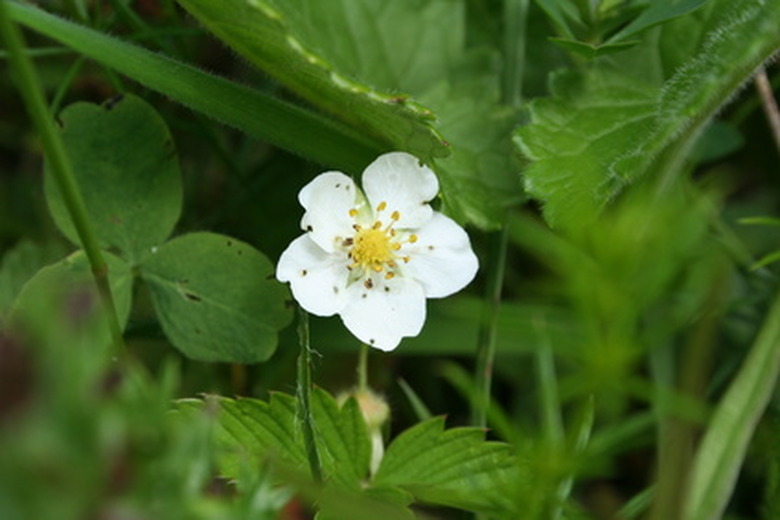How To Plant Strawberries In Pennsylvania
Things Needed
- Strawberry plants
- Compost
- Shovel
- 2 lbs. 10-10-10 granular fertilizer
- Clean oat or wheat straw
If you've never tried a homegrown strawberry, you're in for a treat. Like corn and tomatoes, fresh-picked strawberries have a taste that can't be duplicated by large, commercial growers. Strawberries are perennial plants, rewarding you with fruit year after year. Growing conditions vary widely throughout Pennyslvania, so consult a local extension office or nursery expert to select strawberry varieties that thrive in your area. June-bearing strawberries, according to the University of Pennsylvania's College of Agricultural Sciences, are the simplest to grow and do well in most parts of Pennsylvania.
Step 1
Lay 2 to 3 inches of compost on the soil and till with a shovel to a depth of 6 inches. Plant strawberries in a sandy or loamy soil with good drainage. Adding amendments to the soil may not be necessary for gardeners in the Conestoga Valley and Piedmont Upland areas, while gardeners in Northwest Pennsylvania, where heavy, clay soils predominate, may need more.
- If you've never tried a homegrown strawberry, you're in for a treat.
- Like corn and tomatoes, fresh-picked strawberries have a taste that can't be duplicated by large, commercial growers.
Step 2
Plant healthy nursery stock when the ground is workable, usually mid-March for warm areas near Philadelphia or late April for other parts of Pennsylvania. Place the strawberry roots in water 30 minutes before planting, if you're planting bare-root varieties. Dig holes with a shovel approximately 6 inches deep and 6 inches wide, depending on the size of the plant. Slide the plant gently into the hole, spreading the roots out slightly. Backfill the hole with soil and gently pat it down. Position the strawberries in the soil at the place where the roots meet the crown of the plant. Space strawberry plants 18 to 24 inches apart and space rows 36 inches apart. Water the plants immediately after planting until evenly moist, but not soggy, using a sprinkler, soaker hose or slow running hose.
- Plant healthy nursery stock when the ground is workable, usually mid-March for warm areas near Philadelphia or late April for other parts of Pennsylvania.
- Dig holes with a shovel approximately 6 inches deep and 6 inches wide, depending on the size of the plant.
Step 3
Apply 2 lbs. of 10-10-10 granular fertilizer per 100 feet of row after planting. Broadcast by hand, according to package directions, and irrigate for 30 minutes to activate the fertilizer. Apply an additional 2 lbs. of fertilizer per 100 feet of row in late August.
Step 4
Pinch off all buds the first year to promote healthy plant growth and the reward will be more productive plants the next year.
Step 5
Water strawberry plants during extended dry periods, although Pennsylvania summers usually are moist enough that additional irrigation won't be needed. Water the plants until evenly moist if the soil feels dry 3 or 4 inches under the surface.
- of 10-10-10 granular fertilizer per 100 feet of row after planting.
Step 6
Remove weeds after the harvest in June. Thin the strawberry patch to one plant every 3 to 4 inches in August, before giving it fertilizer. Remove "mother" plants that or 3 or 4 years old, and keep young "daughter" plants. Clip off or mow all the leaves to keep the plant from becoming an overgrown, unproductive mess.
Step 7
Apply a 4-inch layer of weed-free wheat or oat straw in December to protect plants from heaving out of the ground by rapid freezes and thaws. Apply mulch in October or November in high-altitude areas such as the Allegheny High Plateaus and the Blue Ridge. Remove the mulch in mid-March when new growth appears.
- Remove weeds after the harvest in June.
- Apply a 4-inch layer of weed-free wheat or oat straw in December to protect plants from heaving out of the ground by rapid freezes and thaws.
Tip
Homeowners in the Allegheny High Plateaus or Blue Ridge regions should consider alpine strawberries, a variety grown specifically in mountainous regions with poor soil and short growing seasons. Grow these in containers if your soil is particularly gravelly. Harvest strawberries 28 to 30 days after blooming. Harvest early in the morning and chill immediately. Don't wash strawberries until you're ready to use them. Wondering how to tell the difference between mother and daughter plants? Mother plants usually grow in the middle of the row and are bigger than the daughter plants.
Warning
Over-watering causes strawberries to have a diluted flavor and soft texture.
